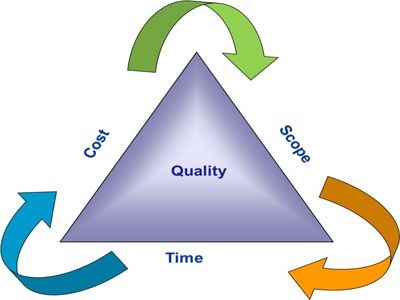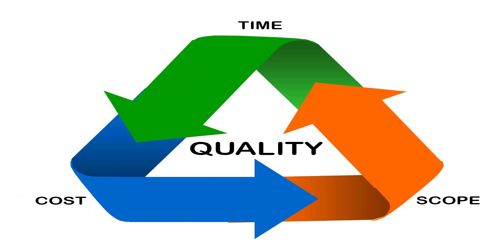Triple Constraints of Project Management
Project management is a systematic process of planning, organizing, analyzing, implementing, and controlling of project’s to ensure the best possible use of resources. It is the application of knowledge, skills, and techniques to execute projects effectively and efficiently
The triple constraint is the combination of the three most significant restrictions on any project: scope, schedule, and cost. The triple constraint is sometimes referred to as the project management triangle or the iron triangle.
In the tropical triangle model scope, schedule and cost are constraints that form the sides of the triangle with quality as the central theme. (An alternative to the triangle, the project management diamond, adds quality to the fourth side of the model and changes the central theme to customer expectations.)

Fig: Triple Constraints of Project Management
The three constraints are interdependent: None of them can be altered without affecting one or both of the others. For example, if the scope of a project is increased, it is likely to take longer and/or cost more. Likewise, an earlier deadline is almost certain to either require more money or a less ambitious scope.
- Cost: All projects have a finite budget; the customer is willing to spend a certain amount of money for delivery of a new product or service. If you reduce the project’s cost, you will either have to reduce its scope or increase its time.
- Time (Schedule): As the saying goes, ‘time is money’, a commodity that slips away too easily. Projects have a deadline date for delivery. When you reduce the project’s time, you will either have to increase its cost or reduce its scope.
- Scope: Many projects fail on this constraint because the scope of the project is either not fully defined or understood from the start. When you increase a project’s scope, you will either have to increase its cost or time.
The difficulty of satisfying expectations for all three constraints is sometimes expressed as pick two: the concept that in any set of three desired qualities, only two can be delivered. If, for example, clients want to keep the budget low, the product is likely to take longer or be of lower quality.
More recently, the triangle has given way to a project management diamond: cost, time, scope, and quality are now the four vertices, with customer expectations as a central theme. No two customer expectations are the same, so you must ask specific questions about the customers’ expectations.
















